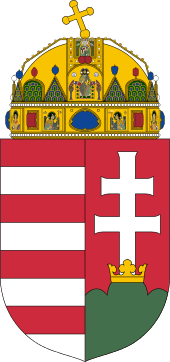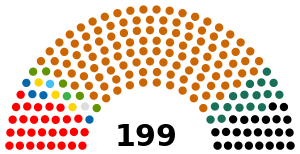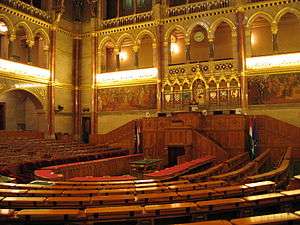National Assembly (Hungary)
| National Assembly Országgyűlés | |
|---|---|
 | |
| Type | |
| Type | |
| Leadership | |
|
Gergely Gulyás, Fidesz Sándor Lezsák, Fidesz István Jakab, Fidesz János Latorcai, KDNP István Hiller, MSZP Tamás Sneider, Jobbik | |
| Structure | |
| Seats | 199 |
 | |
Political groups | |
| Elections | |
|
Mixed Member Majoritarian (Parallel voting) | |
Last election | 6 April 2014 |
Next election | No later than 2018 |
| Meeting place | |
 | |
|
Hungarian Parliament Building Lajos Kossuth Square 1 Budapest, H-1055 Hungary | |
| Website | |
| National Assembly | |
 |
| This article is part of a series on the politics and government of Hungary |
| Foreign relations |
The National Assembly (Hungarian: Országgyűlés; “Country Assembly”) is the parliament of Hungary. The unicameral body consists of 199 (was 386 between 1990 and 2014) members elected to 4-year terms. Election of members is based on a complex system involving both area and list election; parties must win at least 5% of the popular vote in order to enter the list of members of the assembly (but area winners enter regardless). The Assembly includes 25 standing committees to debate and report on introduced bills and to supervise the activities of the ministers. The Constitutional Court of Hungary has the right to challenge legislation on the grounds of constitutionality. The assembly has met in the Hungarian Parliament Building in Budapest since 1902.
History
The Diet of Hungary[1] (Hungarian: Országgyűlés) was a legislative institution in the medieval kingdom of Hungary from the 1290s,[2] and in its successor states, Royal Hungary and the Habsburg kingdom of Hungary throughout the Early Modern period. The name of the legislative body was originally "Parlamentum" during the Middle Ages, the "Diet" expression gained mostly in the Early Modern period.[3] It convened at regular intervals with interruptions during the period of 1527 to 1918, and again until 1946.
The articles of the 1790 diet set out that the diet should meet at least once every 3 years, but, since the diet was called by the Habsburg monarchy, this promise was not kept on several occasions thereafter. As a result of the Austro-Hungarian Compromise, it was reconstituted in 1867.
The Latin term Natio Hungarica ("Hungarian nation") was used to designate the political elite which had participation in the diet, consisting of the nobility, the Catholic clergy, and a few enfranchised burghers,[4][5] regardless of language or ethnicity.[6] Natio Hungarica was a geographic, institutional and juridico-political category.[7]
The democratic character of the Hungarian parliament was reestablished with the fall of the Iron Curtain and the end of communist dictatorship in 1989. Today's parliament is still called Országgyűlés just like in royal times, but in order to differentiate between the historical royal diet is referred to as "National Assembly" now.
2010–2014 Parliament
At the sixth parliamentary elections, four parties or party alliances passed the minimum threshold: the Fidesz – Hungarian Civic Union in alliance with the Christian Democratic People's Party (KDNP) (263 seats in common, 227 for Fidesz and 36 for KDNP). Fidesz-KDNP candidates won enough seats to achieve a two-thirds majority required to modify major laws and the country's constitution. The Hungarian Socialist Party (MSZP) won 59 seats, while its former coalition party Alliance of Free Democrats (SZDSZ) failed to win any seats and became extra-parliamentary after 20 years. There were two newcomers to the Országgyűlés: Jobbik (47 seats) and Politics Can Be Different (LMP) (16 seats). 1 independent (former Fidesz member Oszkár Molnár) got into the Parliament, winning a constituency (Edelény) in Borsod-Abaúj-Zemplén County.
The other prestigious party, the Hungarian Democratic Forum also lost all its seats.
The heads of the factions are:
- Fidesz: Lajos Kósa
- MSZP: József Tóbiás
- Jobbik: Gábor Vona
- KDNP: Péter Harrach
- LMP: András Schiffer
The new parliamentary session hold the inaugural session on 14 May 2010. The President of Fidesz and Prime Minister is Viktor Orbán. Pál Schmitt served as Speaker of the National Assembly until August 2010 when he became President of Hungary. He was replaced by László Kövér.
After the 2010 local elections, held on the 3rd of October, Katalin Szili founded the Social Union and became its first chairperson. As a result, she quit the Hungarian Socialist Party and their parliamentarian group. Continuing the parliamentarian work as formally independent MP.[8]
2006–2010 Parliament
At parliamentary elections in 2006, four parties or party alliances passed the minimum threshold: the Hungarian Socialist Party (MSZP) (190 seats), the coalition party Alliance of Free Democrats (SZDSZ) (20 seats), the Fidesz – Hungarian Civic Union in alliance with the Christian Democratic People's Party (KDNP) (164 seats in common, 141 for Fidesz and 23 for KDNP), and the Hungarian Democratic Forum (MDF) (11 seats) and 1 independent (István Gyenesei) got into the Parliament, winning a constituency in Somogy county.
The heads of the factions were:
- MSZP: Ildikó Lendvai (2006–2009), Attila Mesterházy (2009–2010)
- Fidesz: Tibor Navracsics
- KDNP: Zsolt Semjén
- SZDSZ: Gábor Kuncze (2006–2007), Mátyás Eörsi (2007), János Kóka (2007–2010).
- MDF: Károly Herényi (2006–2009). The faction of MDF broke up in 2009.
The head of the allied faction Fidesz-KDNP was Viktor Orbán. The head of the minority government (since 2008, when SZDSZ left the coalition) was Prime Minister Ferenc Gyurcsány then Gordon Bajnai. The speaker of the Assembly was Katalin Szili (2006-2009) then Béla Katona (2009-2010) of the MSZP.
Speakers of the National Assembly of Hungary
Latest election
| Parties and coalitions | Party list | Constituency | Total seats | |||||||||
|---|---|---|---|---|---|---|---|---|---|---|---|---|
| Votes | % | +/− | Seats | Votes | Seats | Seats | +/− | % | +/− | |||
| Fidesz–KDNP party alliance Fidesz–KDNP pártszövetség |
Fidesz – Hungarian Civic Union (Fidesz) Fidesz – Magyar Polgári Szövetség |
2,264,780 | 44.87 | |
30 | 2,165,342 | 87 | 117 | 66.83 | |||
| Christian Democratic People's Party (KDNP) Kereszténydemokrata Néppárt |
7 | 9 | 16 | |||||||||
| Unity Összefogás |
Hungarian Socialist Party (MSZP) Magyar Szocialista Párt |
1,290,806 | 25.57 | 21 | 1,317,879 | 8 | 29 | 19.10 | ||||
| Together – Party for a New Era (Együtt) Együtt – A Korszakváltók Pártja |
New | 2 | 1 | 3 | New | |||||||
| Democratic Coalition (DK) Demokratikus Koalíció |
3 | 1 | 4 | |||||||||
| Dialogue for Hungary (PM) Párbeszéd Magyarországért |
1 | 0 | 1 | |||||||||
| Hungarian Liberal Party (MLP) Magyar Liberális Párt |
1 | 0 | 1 | |||||||||
| Movement for a Better Hungary (Jobbik) Jobbik Magyarországért Mozgalom |
1,020,476 | 20.22 | 23 | 1,000,637 | 0 | 23 | 11.56 | |||||
| Politics Can Be Different (LMP) Lehet Más a Politika |
269,414 | 5.34 | 5 | 244,191 | 0 | 5 | 2.51 | |||||
| Hungarian Workers' Party Magyar Munkáspárt |
28,323 | 0.56 | 0 | 12,716 | 0 | 0 | 0 | 0 | ||||
| The Homeland Not For Sale Movement Party (HNEM) A Haza Nem Eladó Mozgalom Párt |
23,507 | 0.47 | New | 0 | 23,037 | 0 | 0 | New | 0 | 0 | ||
| Alliance of Mária Seres (SMS) Seres Mária Szövetségesei |
22,219 | 0.44 | 0 | 20,229 | 0 | 0 | 0 | 0 | ||||
| Party of Greens (Greens) Zöldek Pártja |
18,557 | 0.37 | 0 | 9,392 | 0 | 0 | 0 | 0 | ||||
| Social Democratic Hungarian Civic Party (Soc Dems) Szociáldemokraták Magyar Polgári Pártja |
15,073 | 0.3 | 0 | 12,232 | 0 | 0 | 0 | 0 | ||||
| Together 2014 Party Együtt 2014 Párt |
14,085 | 0.28 | New | 0 | 6,361 | 0 | 0 | New | 0 | 0 | ||
| Party for a Fit and Healthy Hungary (SEM) Sportos és Egészséges Magyarországért Párt |
12,563 | 0.25 | New | 0 | 11,746 | 0 | 0 | New | 0 | 0 | ||
| Community for Social Justice People's Party (KTI) Közösség a Társadalmi Igazságosságért Néppárt |
10,969 | 0.22 | New | 0 | 10,551 | 0 | 0 | New | 0 | 0 | ||
| Democratic Community of Welfare and Freedom (JESZ) Jólét és Szabadság Demokratikus Közösség |
9,925 | 0.2 | New | 0 | 13,051 | 0 | 0 | New | 0 | 0 | ||
| Gypsy Party of Hungary (MCP) Magyarországi Cigány Párt |
8,810 | 0.17 | New | 0 | 9,030 | 0 | 0 | New | 0 | 0 | ||
| Independent Smallholders Party (FKGP) Független Kisgazdapárt |
8,083 | 0.16 | 0 | 7,175 | 0 | 0 | 0 | 0 | ||||
| Unity Party (ÖP) Összefogás Párt |
6,552 | 0.13 | 0 | 6,887 | 0 | 0 | 0 | 0 | ||||
| New Dimension Party (ÚDP) Új Dimenzió Párt |
2,100 | 0.04 | New | 0 | 1,706 | 0 | 0 | New | 0 | 0 | ||
| New Hungary Party (ÚMP) Új Magyarország Párt |
1,578 | 0.03 | New | 0 | 2,018 | 0 | 0 | New | 0 | 0 | ||
| Others and Independent candidates | – | – | – | – | 34,432 | 0 | 0 | 0 | ||||
| 13 minority lists (needed 22,022 votes/list for a mandate) | 19,543 | 0.38 | – | – | – | – | – | – | – | – | ||
| Total (turnout 61.73% |
5,047,363 | 100% | – | 93 | 4,908,608 | 106 | 199 | 100% | – | |||
| Source: National Election Office (100.00% reporting) | ||||||||||||
Historic mandates
| 1990–1994: |
| ||||||||||||
| 1994–1998: |
| ||||||||||||
| 1998–2002: |
| ||||||||||||
| 2002–2006: |
| ||||||||||||
| 2006–2010: |
| ||||||||||||
| 2010–2014: |
| ||||||||||||
| 2014–2018: |
| ||||||||||||
| |||||||||||||
Members (since 1990)
References
- ↑ András Gergely, Gábor Máthé: The Hungarian state: thousand years in Europe (published in 2000)
- ↑ Elemér Hantos: The Magna Carta Of The English And Of The Hungarian Constitution (1904)
- ↑ Cecil Marcus Knatchbull-Hugessen Brabourne (4th Baron): The political evolution of the Hungarian nation: (Volume I. in 1908)
- ↑ John M. Merriman, J. M. Winter, Europe 1789 to 1914: encyclopedia of the age of industry and empire, Charles Scribner's Sons, 2006, p. 140, ISBN 978-0-684-31359-7
- ↑ Tadayuki Hayashi, Hiroshi Fukuda, Regions in Central and Eastern Europe: past and present, Slavic Research Center, Hokkaido University, 2007, p. 158, ISBN 978-4-938637-43-9
- ↑ Katerina Zacharia, Hellenisms: culture, identity, and ethnicity from antiquity to modernity, Ashgate Publishing, Ltd., 2008, p. 237 ISBN 978-0-7546-6525-0
- ↑ http://www.hungarianhistory.com/lib/transy/transy05.htm
- ↑ Szili Katalin kilépett az MSZP-frakcióból
External links
- (English) Official website
- (Hungarian) Official website
Coordinates: 47°30′26″N 19°02′45″E / 47.50722°N 19.04583°E